Explore the life, art, and feminist influence of Amrita Sher-Gil through her introspective self-portraits. Discover how this pioneering Indian artist blended Eastern and Western influences to forge a unique style that challenged traditional gender roles and expressed her complex identity. Learn about her techniques, cultural impact, and legacy as a feminist icon in modern art.
- Introduction: The Resonant Art of Amrita Sher-Gil
- Early Life and Artistic Beginnings
- Development of a Personal Style in Self-Portraiture
- Exploration of Feminism in Sher-Gil's Self-Portraits
- Techniques and Artistic Innovations
- Cultural Significance of Sher-Gil's Work
- Conclusion
- Explore More About Amrita Sher-Gil
- How did Amrita Sher-Gil's self-portraits influence modern Indian art?
- What themes are commonly found in Amrita Sher-Gil's self-portraits?
- How many self-portraits did Amrita Sher-Gil create, and over what period?
- Are there any significant stylistic changes in Sher-Gil's self-portraits over the years?
- What techniques did Amrita Sher-Gil use to create her self-portraits?
- How are Sher-Gil's self-portraits received and interpreted in contemporary art circles?
- Can viewers see Amrita Sher-Gil's self-portraits in any museums or galleries today?
- What impact did Amrita Sher-Gil's Hungarian heritage have on her self-portraits?
Introduction: The Resonant Art of Amrita Sher-Gil
Amrita Sher-Gil, often heralded as a pivotal figure in Indian modern art, remains an enigmatic presence whose self-portraits convey depths of introspection and a profound narrative of identity. Born in 1913 to a Hungarian mother and Indian father, Sher-Gil’s art seamlessly blends Eastern and Western artistic traditions, positioning her as a bridge between two distinct worlds. This article delves into her self-portraits, which not only showcase her exceptional talent but also her unwavering commitment to expressing the female experience through a distinctly feminist lens.
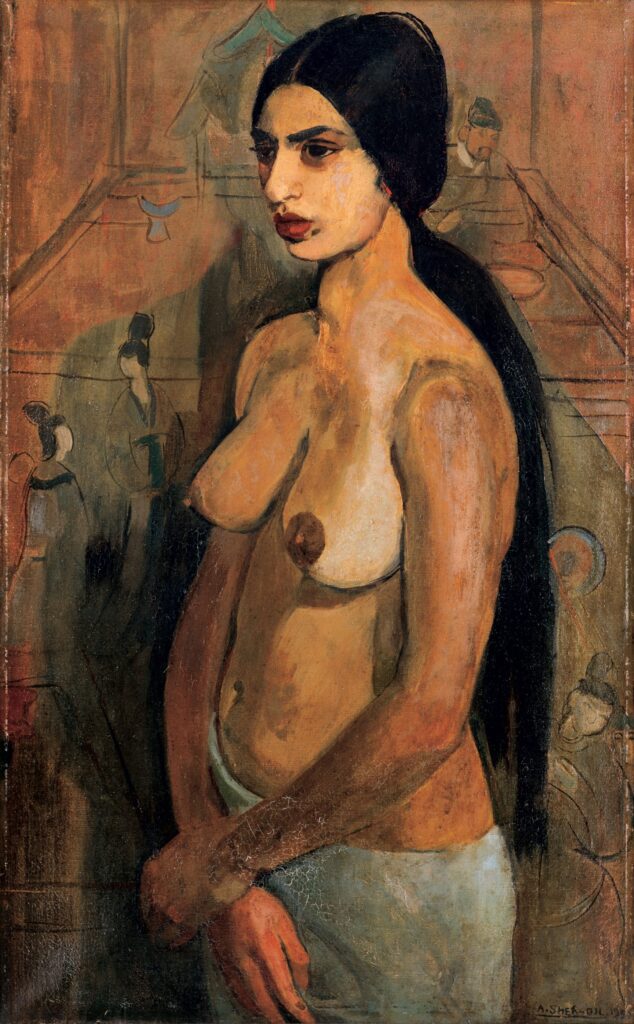
Through her paintings, Sher-Gil did not merely portray her physical self but also articulated a more profound engagement with the personal and cultural dilemmas of her time. Her self-portraits are an exploration of identity, a commentary on gender roles, and a candid examination of the self, all while being deeply rooted in the socio-political context of early 20th-century India. This article seeks to unravel the layers of Sher-Gil’s self-portraits, revealing how they encapsulate the inner life of a woman who was far ahead of her time, both as an artist and a feminist icon.
For those interested in exploring more about Amrita Sher-Gil’s artworks and her contributions to Indian modern art, the National Gallery of Modern Art in New Delhi hosts several of her pieces. Visit their official website to view current exhibitions and collections.
Early Life and Artistic Beginnings
Amrita Sher-Gil’s journey into the art world began with her birth in Budapest, Hungary, and her subsequent upbringing in a family that valued art and culture highly. Her mother, Marie Antoinette Gottesmann, was an opera singer and a proficient pianist, while her father, Umrao Singh Sher-Gil Majithia, was a scholar of Sanskrit and Persian. This blend of Hungarian and Indian heritage not only influenced Sher-Gil’s personal identity but also deeply impacted her artistic style.
From an early age, Sher-Gil was exposed to the world of art. She started painting at the age of five and by her teenage years, she was already proficient in the basics of drawing and painting, thanks to the guidance of her uncle, Ervin Baktay. Recognizing her potential, her family moved to Paris in 1929, where Sher-Gil enrolled at the École des Beaux-Arts. In Paris, she was exposed to European painters, from the Impressionists to the Post-Impressionists, and began to absorb and reinterpret these styles through her unique lens.
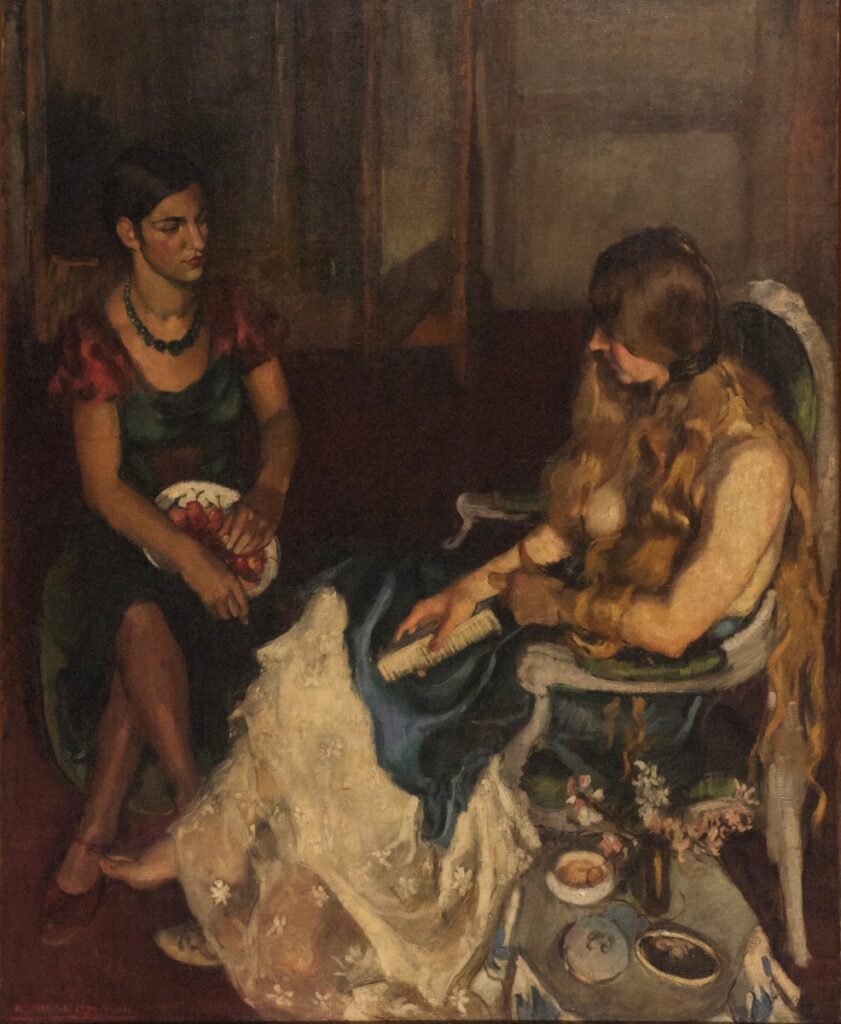
During her years in Europe, Sher-Gil’s early works were primarily influenced by Western styles and themes. However, her artistic direction underwent a significant transformation upon her return to India in 1934. It was then that she began to engage more deeply with Indian subjects and themes, which became a hallmark of her later works. This period marked the beginning of Sher-Gil’s transition into a style that was entirely her own, blending European techniques with a distinctly Indian sensibility.
Development of a Personal Style in Self-Portraiture
Upon her return to India, Amrita Sher-Gil embarked on a transformative journey that led her to forge a unique artistic identity, particularly evident in her self-portraits. These works stand out not only for their aesthetic quality but also for their introspective depth, showcasing a maturation of her artistic voice.
Sher-Gil’s self-portraits from this period display a bold, introspective look that challenges the viewer while also inviting them into her inner world. Unlike the traditional depictions of women in Indian art of the time, her self-portraits convey a strong sense of self-awareness and autonomy. This was a radical departure from the more decorative roles women often played in Indian artistic narratives.
In her self-portraiture, Sher-Gil often portrayed herself with an introspective solemnity, capturing various facets of her identity and emotions. These paintings are characterized by rich, vibrant colors and a robust use of line and form, techniques she mastered during her training in Paris but adapted to reflect her hybrid cultural heritage. Her style is often described as a fusion of Western modernist sensibilities and the earthy hues of traditional Indian painting.
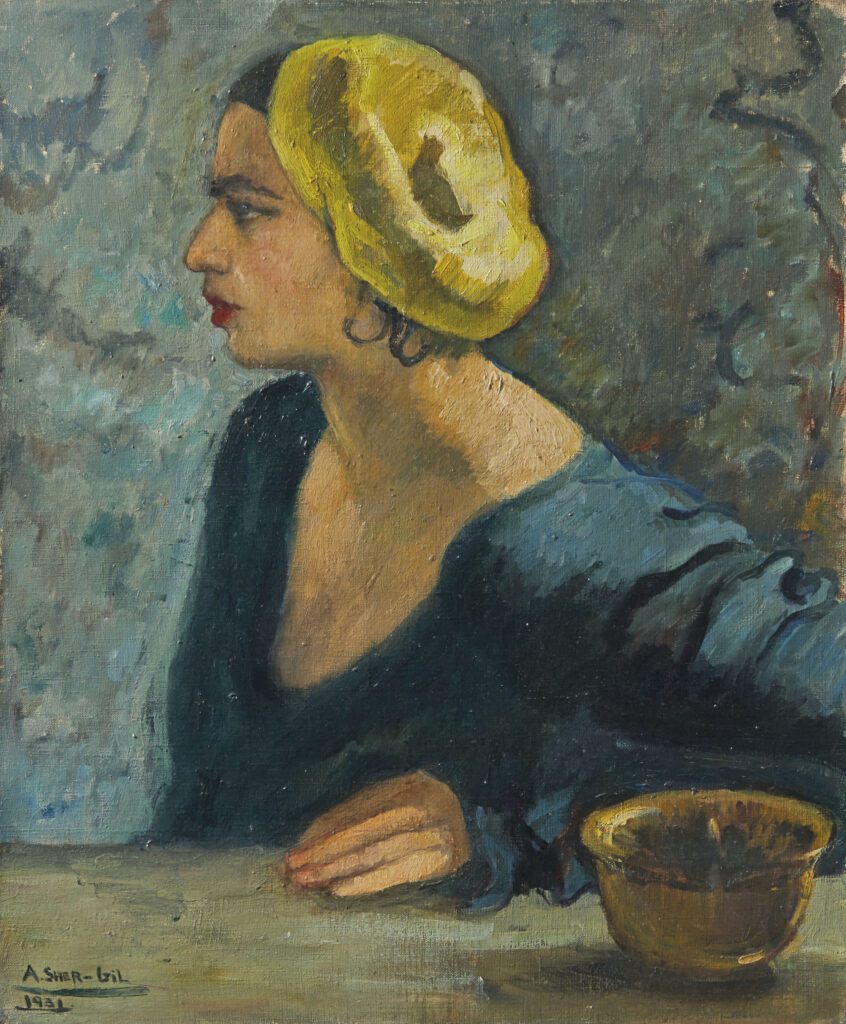
Moreover, her self-portraits are replete with symbolic elements that reflect her personal struggles and cultural critique. For instance, her use of European style clothing and traditional Indian attire in different portraits speaks to her ongoing exploration of her dual heritage and the intersection of her identity as both European and Indian.
Through her self-portraits, Sher-Gil not only charted her own emotional and psychological landscape but also made a profound statement on the autonomy of the artist, particularly a female artist, in the early 20th century. Her works are a dialogue between her inner life and her outer experiences, bridging her personal narrative with broader cultural and feminist themes.
Exploration of Feminism in Sher-Gil’s Self-Portraits
Amrita Sher-Gil’s self-portraits are not just reflections of her physical appearance; they are powerful statements of her feminist ideology, showcasing her progressive views on women’s roles and identities. Through her art, Sher-Gil articulated a vision that was both ahead of her time and deeply rooted in the cultural struggles of her era.
In many of her self-portraits, Sher-Gil portrayed herself as a confident and assertive individual, breaking away from the traditional passive representations of women in Indian art. Her gaze is often direct and challenging, engaging the viewer in a silent conversation about gender and power. This directness was a declaration of self-sovereignty and a rebuke to societal norms that viewed women as secondary.
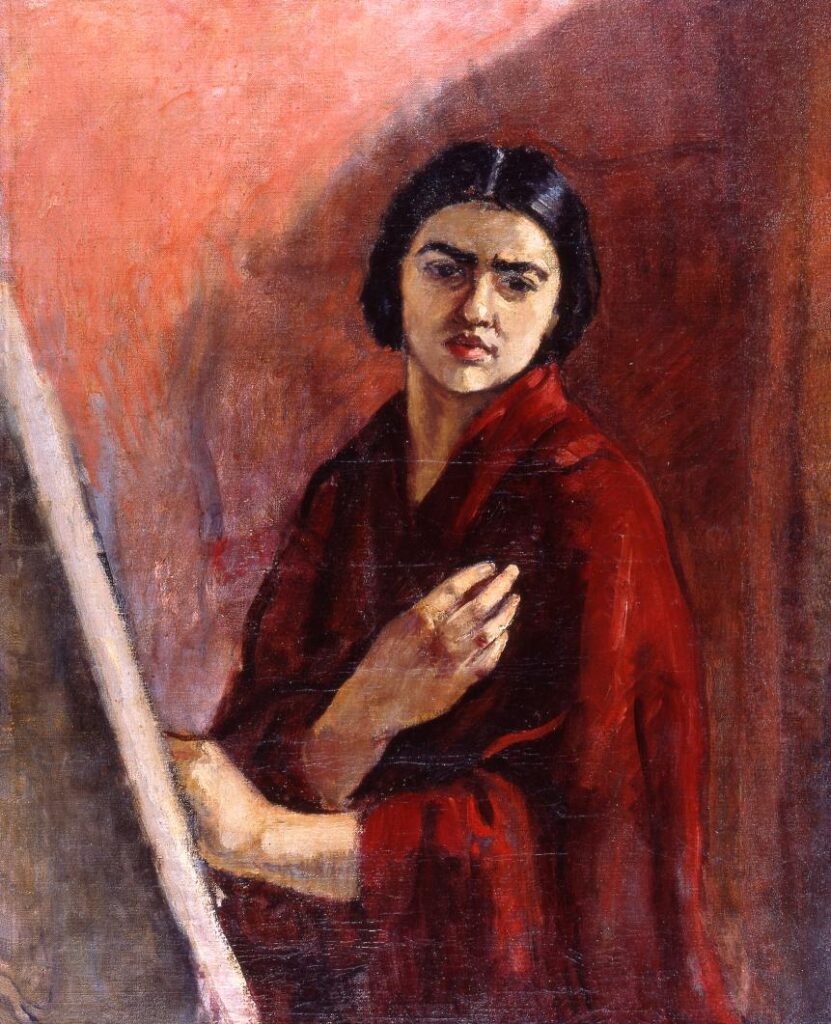
Sher-Gil’s use of symbolism in her self-portraits also speaks volumes about her feminist leanings. For example, her often sparse or undefined backgrounds focus attention on the subject herself, emphasizing the individuality and importance of women as independent entities, not just as part of a larger familial or societal structure. Her choice of bold, non-conformist colors and attire in her self-portraits further underlines her rejection of traditional feminine roles prescribed by society.
Moreover, Sher-Gil’s exploration of her own identity and sexuality through her art was revolutionary. Her self-portraits explore themes of self-knowledge, loneliness, and introspection, which are crucial elements of the feminist discourse about understanding and liberating the self from societal expectations.
Sher-Gil’s impact extends beyond her lifetime, influencing generations of female artists in India who see her as a pioneer who paved the way for discussions about women’s rights and feminist issues through the medium of art. Her work has been revisited numerous times as a foundational example of feminist art in India, resonating with new generations who continue to struggle with many of the same issues she depicted.
Techniques and Artistic Innovations
Amrita Sher-Gil’s self-portraits are renowned not only for their emotional depth and feminist themes but also for their distinctive artistic techniques. Her approach combined the formal training she received in Europe with the sensibilities and motifs of Indian art, resulting in a style that was entirely her own and revolutionary for its time.
- Color Palette: One of the most striking aspects of Sher-Gil’s work is her use of color. She often chose earthy tones—browns, ochres, and reds—that are reminiscent of the landscapes and skin tones found in India. This choice was deliberate, aiming to represent the true essence of India, contrasting sharply with the more vibrant palettes used in European paintings. In her self-portraits, these colors often reflect her mood and emotional state, using them to convey depth and complexity.
- Brushwork and Texture: Sher-Gil’s brushwork varied from smooth and finely blended to bold and expressive, demonstrating her ability to manipulate texture to enhance the emotional impact of her paintings. Her technique evolved over her career, moving from the detailed and precise strokes of her early training to a looser, more expressive style that better captured the spontaneity and vibrancy of her subjects.
- Composition and Framing: Sher-Gil’s self-portraits are particularly noted for their innovative composition. Often, she placed herself off-center or partially obscured, which created a dynamic and somewhat unsettling effect. This unconventional framing added to the narrative of her portraits, suggesting a sense of movement or change and emphasizing the complexity of her identity.
- Symbolism: Beyond technical elements, Sher-Gil’s work is rich in symbolism. In her self-portraits, objects, and backgrounds are chosen with care to reflect broader themes of life, death, sexuality, and rebirth. These symbols were not merely decorative but were integral to the storytelling of her art, contributing layers of meaning that invite viewers to look deeper.
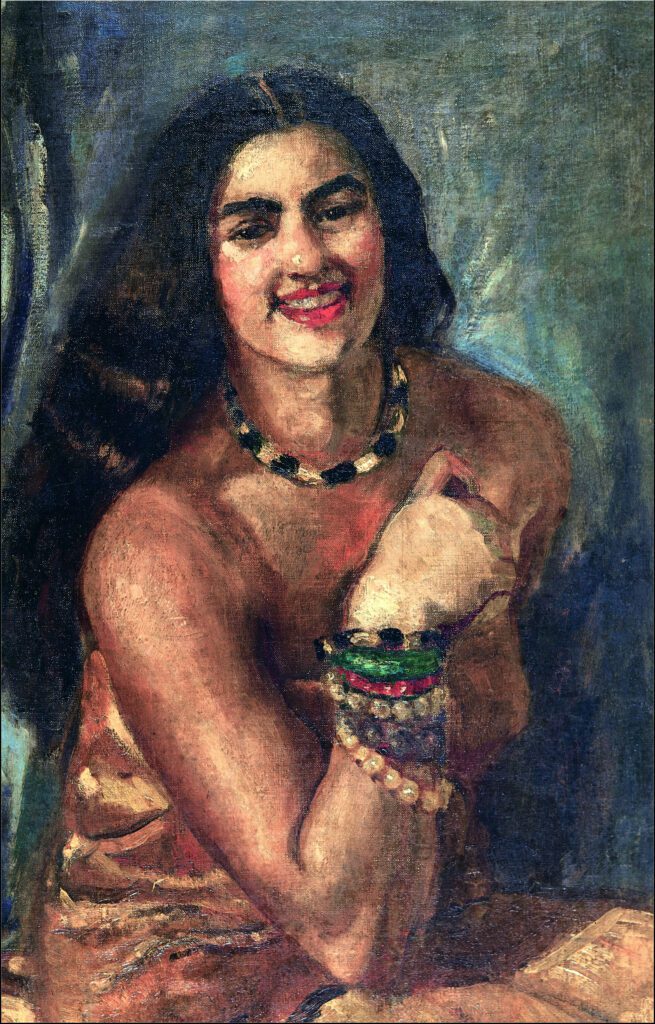
Through these techniques, Amrita Sher-Gil not only crafted images of striking beauty and profound depth but also pushed the boundaries of what Indian art could express and represent. Her innovative approach to art-making helped pave the way for modern Indian artists, influencing how they depict themes of identity, culture, and feminism.
To understand the broader context of Sher-Gil’s impact on the art world and her feminist iconography, the Tate Modern occasionally features articles and exhibitions on South Asian modernists, including Sher-Gil. Explore these insights on Tate’s website.
Cultural Significance of Sher-Gil’s Work
Amrita Sher-Gil’s contributions to Indian art cannot be overstated, as her work transcends the aesthetic to echo the cultural and feminist narratives of her time, making a lasting impact on both the art world and broader societal views.
- Reflection of Indian Society: Sher-Gil’s self-portraits and broader oeuvre provide a window into the lives and struggles of Indian women during the early 20th century. Her work reflects the tension between tradition and modernity, a central theme in a newly independent India grappling with its identity. By portraying realistic, often raw images of Indian women, Sher-Gil challenged the exotic and romanticized depictions prevalent in both Indian and European art of the period.
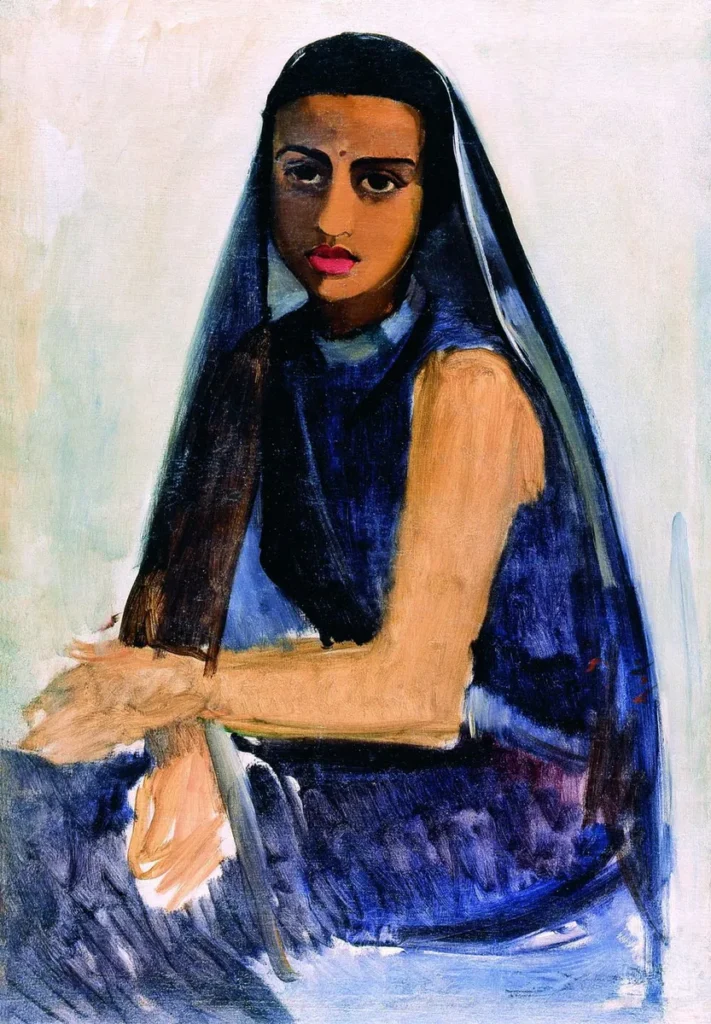
- Influence on Modern Indian Art: Sher-Gil is often called the “Indian Frida Kahlo” for her introspective and bold self-portraits that explore deep personal and cultural themes. Her influence is evident in the generations of Indian artists who followed, many of whom cite her as an inspiration for their focus on personal narrative and cultural critique in art. Her pioneering blend of Western techniques with Indian subjects helped lay the groundwork for a modern Indian artistic identity.
- Recognition and Legacy: During her lifetime, Sher-Gil’s work was groundbreaking, and it often met with mixed reactions. However, over the decades, her paintings have gained immense respect and admiration, both in India and internationally. Her art has been posthumously celebrated in numerous exhibitions, and her life and work have been the subject of books, films, and scholarly research, cementing her status as one of the most important figures in Indian art history.
- Feminist Icon: Beyond art, Sher-Gil’s life and work continue to inspire feminist discourse in India. Her assertive depictions of herself and other women, her exploration of her own identity and autonomy, and her critique of the societal norms of her time resonate with current feminist issues. Sher-Gil remains a symbol of the fight for women’s rights and recognition in society, her art a lasting testament to her revolutionary spirit.
Amrita Sher-Gil’s contributions to Indian art cannot be overstated, as her work transcends the aesthetic to echo the cultural and feminist narratives of her time, making a lasting impact on both the art world and broader societal views. Her self-portraits, rich with emotion and cultural symbolism, have firmly established her as a foundational figure in modern Indian art history. Her paintings reflect the tension between tradition and modernity, a theme that has persisted in the Indian consciousness long after her passing.
For readers interested in exploring more of her influential artistry, “10 Amrita Sher-Gil Paintings That Changed Indian Art Forever” offers a curated look at the works that cemented her legacy and continue to inspire art enthusiasts around the world
Conclusion
Amrita Sher-Gil’s self-portraits unveil not just the artist’s face but her innermost thoughts and a profound narrative on cultural identity, gender, and existence. Through her canvases, Sher-Gil communicated complex, often controversial themes that challenged the perceptions of her time and continue to inspire today. Her legacy as an artist and a feminist icon endures, her work a beacon for those who seek to understand the power of art as a mirror to society and a tool for change.
Explore More About Amrita Sher-Gil
For further exploration of Amrita Sher-Gil’s life, art, and the contexts she influenced and was influenced by, consider visiting the following resources:
- National Gallery of Modern Art, New Delhi: View Sher-Gil’s works and learn about her exhibitions here.
- The Amrita Sher-Gil Archive: Dive deep into Sher-Gil’s biography, artwork analysis, and photographs here.
- Tate Modern: Read about global perspectives on Sher-Gil and other South Asian modernists here.
- The Partition Museum: Gain insights into the historical era of Sher-Gil here.
- SaffronArt: Explore and purchase artworks, and learn about the market for Sher-Gil’s paintings here.
- Artsy Editorial: Discover contemporary critiques and analyses of Sher-Gil’s art here.
FAQs
How did Amrita Sher-Gil’s self-portraits influence modern Indian art?
Amrita Sher-Gil’s self-portraits brought a new level of emotional depth and personal narrative to Indian art. Her blend of Western techniques with Indian themes challenged the existing norms and laid a foundation for future artists to explore more introspective and individualistic expressions.
What themes are commonly found in Amrita Sher-Gil’s self-portraits?
Common themes include self-exploration, cultural identity, feminism, and the human condition. Her work often reflects her personal struggles with identity and the position of women in society.
How many self-portraits did Amrita Sher-Gil create, and over what period?
Amrita Sher-Gil was known to have created several self-portraits throughout her career, particularly during the 1930s. However, the exact number is not well-documented as some may be privately owned or yet to be discovered.
Are there any significant stylistic changes in Sher-Gil’s self-portraits over the years?
Yes, Sher-Gil’s style evolved from her early years in Paris, with more detailed and classical influences, to a bolder, more expressive technique that incorporated Indian subjects and themes as she matured artistically.
What techniques did Amrita Sher-Gil use to create her self-portraits?
Sher-Gil used a variety of techniques, including layering, glazing, and impasto, to build depth and texture. Her brushwork varied from finely detailed to more expressive strokes as she evolved her style.
How are Sher-Gil’s self-portraits received and interpreted in contemporary art circles?
Today, Amrita Sher-Gil’s self-portraits are celebrated for their pioneering spirit and are considered seminal works that bridged European and Indian art forms. They are often studied for their feminist undertones and rich cultural commentary.
Can viewers see Amrita Sher-Gil’s self-portraits in any museums or galleries today?
Yes, many of Sher-Gil’s self-portraits are on display in prominent institutions such as the National Gallery of Modern Art in New Delhi, and some are featured in international galleries and exhibitions.
What impact did Amrita Sher-Gil’s Hungarian heritage have on her self-portraits?
Sher-Gil’s European heritage is evident in the technique and composition of her work, but she also used this influence to contrast and highlight Indian themes, creating a unique cross-cultural dialogue within her self-portraits.
